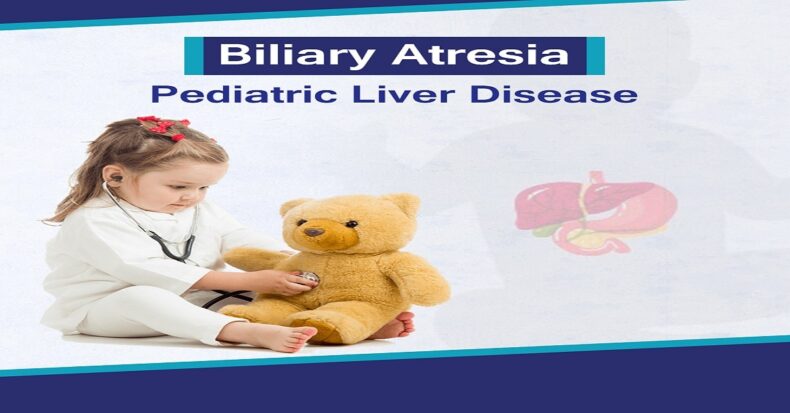Biliary atresia is an uncommon and severe illness that affects newborns. In this extremely rare condition, the bile ducts both inside and outside of the liver as well as the gall bladder do not grow normally from birth.
Despite various theories, the causes of this rare disease are not yet clear. Let’s see what Biliary Atresia is-
Biliary Atresia- what is it
Bile is an enzyme that plays a significant role in the digestion of fats as well as the transportation of waste products. In a healthy body, the bile will go from the liver to the gut via a series of networks and ducts. A disorder known as biliary atresia is extremely uncommon and is characterized by the absence of bile ducts or their blockage. It is extremely rare, occurring in only one child out of every 18,000 newborns.
The liver is damaged irreparably by the accumulation of bile due to this illness. This obstruction can happen either inside the liver (intrahepatic) or even outside the liver (extrahepatic).
What causes Biliary Atresia–
There are two types of biliary atresia: congenital, which means it is present at birth, and acquired, which means it develops during the perinatal period (the first few weeks after birth). Even though the cause is unknown, it is likely that the congenital form is associated with a chromosomal defect, while it is suspected that the acquired form is associated with a viral infection or an autoimmune reaction. However, both of these theories are speculative.
It can be caused due to –
- Virus infection upon birth
- Contact with harmful chemicals
- Multiple genetic variables
- Neonatal injury
- Certain medications, such as carbamazepine
It is more prevalent among people of East Asian and African origin.
Symptoms of Biliary Atresia-
Typically, the first sign of biliary atresia is jaundice, i.e. the yellowing of the skin and whites of the eyes caused by the accumulation of bile in the body. Bilirubin is a reddish-yellow pigment that is found in bile.
Most of the time, symptoms start between 2 and 8 weeks. Jaundice causes the skin and mucus membranes to turn yellow over the course of 2 to 3 weeks after birth. During the first month, the baby may gain weight normally. After that, the baby will start to lose weight, and get cranky, and their jaundice will get worse.
Other possible symptoms include the following:
- Slow growth
- Dark urine
- Abdominal swelling
- Stools that float and smell bad
- Stools that are pale or a clay color
Tests to diagnose biliary atresia–
To diagnose this the doctor will take the child’s medical history and do a physical assessment.
X-ray of the abdomen to look for signs of an enlarged liver or spleen.
Ultrasound examination of the abdomen for examination of the internal organs
Perform tests on your blood to determine your total and direct bilirubin levels.
Hepatobiliary scintigraphy, often known as a HIDA scan, is a test that examines the gall bladder and bile ducts to determine if they are functioning normally.
Biopsy of the liver to determine the extent of the cirrhosis or to rule out other potential causes of jaundice
A Cholangiogram, often known as an x-ray of the bile ducts is performed to determine whether or not the bile ducts are open or closed.
Above mentioned, are the methods to diagnose the disease. Let’s have a look at how to treat Biliary Atresia.
Treatments of Biliary Atresia-
Medication cannot be used to treat biliary atresia. The Kasai procedure (also known as an hepatoportoenterostomy) is a surgical procedure that creates a path for bile to flow from the liver into the intestine.
The surgeon removes the damaged ducts that are located on the surface of the liver (called extrahepatic ducts). They discover smaller ducts that are still open and draining bile despite the obstruction. After that, they will connect a loop of the intestine to that particular section of the liver. Because of this, bile can now enter the intestines from the few healthy bile ducts that are still present.
Following this treatment, infants typically need to remain in the hospital for seven to ten days so that they can recover. Antibiotic treatment over an extended period of time is used to decrease the likelihood of infection. To facilitate bile flow and improve the likelihood of a successful operation, additional drugs may be used.
When performed by skilled hepatologists and surgeons, the Kasai surgery has a success rate of between 60 and 85 percent, depending on the patient. This results in bile draining from the liver, which in turn causes the level of jaundice to decrease.
Biliary atresia cannot be cured with Kasai. It helps newborns develop and stay healthy for years. Studies show that 25% of Kasai patients do not need liver transplants.
If the Kasai procedure is performed early enough and the child’s liver is in good enough condition, he or she may be able to avoid a liver transplant. However, still many patients will still require a liver transplant in the future, even if surgery is successful.

read more : How do you tell the difference between a heart attack and aortic disease?













